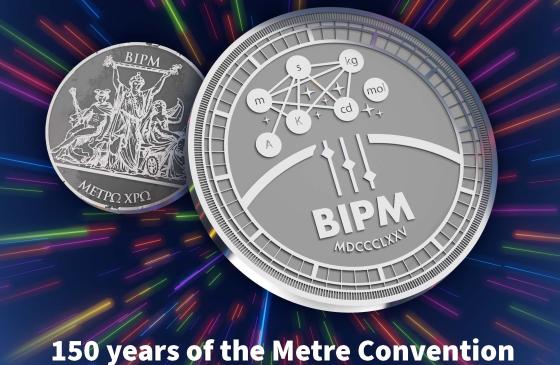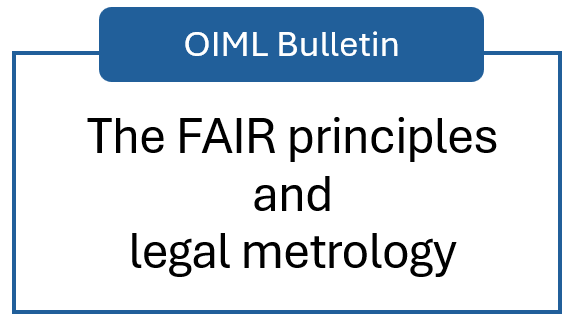OIML BULLETIN - VOLUME LXVI - NUMBER 3 - July 2025
e v o l u t i o n
The future of the OIML in the digital era
From machine-actionable standards and certificates to novel digital services
Sascha Eichstädt 1 and Yang Ping2
1. PTB , Braunschweig, Germany
2. NIM , Beijing, P.R. China
Citation: S. Eichstädt S. and Yang Ping 2025 OIML Bulletin LXVI(3) 20250301
Introduction
The Gartner Glossary [1] defines digitization as the “process of changing from analogue to digital form” in contrast to digitalization as “the use of digital technologies to change a business model” and “the process of moving to a digital business”. The term digital transformation can then be defined as “a business process (a digitalization) enabled by a technical change (a digitization)” (Gartner). In legal metrology, the “transformation” can be considered as processes are evolving towards end-to-end digital processes by replacing physical (i.e., analogue) steps with digital ones. The term “transformation” may also refer to changes in technologies or processes to enable a better handling in some way. It is important to note that this transformation does not necessarily have a defined final state. Instead, it includes an ongoing adoption of new (digital) technologies considered as “facilitators to make metrological services even better” [2].
Digitalization in legal metrology is an essential part of the wider digital transformation in the quality infrastructure. Processes in legal metrology rely on measurement standards, accreditation, conformity assessment, market surveillance and standardization. Thus, digitalization in legal metrology is closely related to digitalization within the rest of the quality infrastructure (QI). In recent years, the QI bodies – nationally and internationally – have started digitalization initiatives of various kinds. In some areas, such as conformity assessment and standardization, machine-readability of information has become a focus topic. In other areas, such as metrology, challenges in handling complex digital systems and artificial intelligence have become increasingly important. At the same time, industries and economies are progressing rapidly, which results in challenges for the quality infrastructure. Some examples of topics that need to be addressed by the quality infrastructure are as follows:
- Large quantity of data sources underpinning new digital services, and novel approaches for data analysis, based on artificial intelligence and machine learning;
- Interconnected, versatile, and often inexpensive sensors, combined in so-called sensor networks as in the “Internet of Things” (IoT);
- Fundamentally new approaches in production, such as additive manufacturing.
The digital transformation challenges the quality infrastructure in various ways. A concrete example with great impact on the economy and society is the digital transformation of the energy transition. Many countries have introduced so-called “smart meters” as an important initial step in this direction. Such smart meters combine metrological requirements with security-related requirements and requirements of verification legislation. This underlines the necessity of strong interdisciplinary collaboration and effective coordination, as it requires core metrological competence as well as digital expertise. Therefore, national and international initiatives have been started in recent years to establish close collaboration and joint developments. The overall aim is to ensure interoperability of data and interfaces as a prerequisite for efficient and sustainable digital transformation of the quality infrastructure and internal trade in the digital era.
In 2022, the Task Group “SI Digital Framework” of the International Committee for Weights and Measures (CIPM) together with the International Bureau of Weights and Measures (BIPM) initiated the “Joint Statement of Intent on the digital transformation in the international scientific and quality infrastructure” [3] (JSI), now signed by ten international organizations – including the OIML. This statement is a commitment to collaborate in the implementation and further development of the International System of Units (SI) for the digital world as well as collaborating in the wider digital transformation. The role of the OIML Digitalization Task Group (DTG) is to translate the Joint Statement of Intent into concrete recommendations and actions for the OIML. The DTG is also the group within the OIML that is actively collaborating with other institutions of the international quality infrastructure under the Joint Statement.
Since its beginning, the OIML DTG has organized and contributed to several workshops and conferences on legal metrology as part of its mission to examine, promote and support activities and ideas on matters relevant for the digitalization in legal metrology and the OIML. One such event was the OIML Seminar “The future of the OIML in the digital era”, on 16th October 2023, in Chiang Mai, Thailand [4]. This Seminar brought together expertise from all the areas the OIML is involved in to discuss and establish the basis for digital transformation in legal metrology and the corresponding role the OIML must play. An important conclusion from the Seminar was the need for training and capacity building to be coordinated by the OIML. Therefore, the DTG organized a series of webinars in 2024 that covered aspects such as digital certificates, blockchain technologies, remote services and data spaces. Furthermore, the DTG created a subcommittee “e-Learning” for the coordination of online learning material on digitalization topics to be published on the OIML e-Learning platform.
Digitalization and the role of the OIML
The digital era has brought about unprecedented changes in all aspects of our lives, and legal metrology is no exception. Consider the potential advancements in accuracy, efficiency, and accessibility that digitalization could bring to legal metrology. Digital technologies transform establishment, dissemination, and potentially also enforcement, of legal requirements and standards. With real-time data capture and automated conformity checks that were previously unachievable, established rules such pre-defined reassessment intervals may no longer appear adequate.
In the analogue era, information and data were communicated with the human person in mind. In the digital era, however, machine-readability and use of software-based automation has become the standard approach. Thus, as measurement traceability and quality assurance migrate into digital ecosystems, the development and adoption of harmonized data models and interoperable interfaces become critical. Machine-readability means that the information from a document, data set or other source can be accessed and used by a software program. This can, for instance, be achieved by using a structured document format such as XML. An XML document contains structured elements with specified names, so-called “tags”, which in turn hold the actual content information. A schema file specifies for the software how the tags are organized, what their relation is to each other and what type of content they contain. An extension of machine-readability of a document is a machine-actionable one. This means that not only can the software extract the required information from the document but can “understand” its content. A very simple example is by extending the XML such that the values contain information about the units of measurement in a standardized data model (e.g., based on the SI Reference Point [5]) or an ontology for units (such as QUDT). More advanced extensions could be based on ontologies for other contents than units of measurement.
Processes in legal metrology rely on the mutual sharing of information and data, technological and regulatory trust frameworks, and common vocabularies. For instance, the conformity assessment for a product requires information from the manufacturer, access to standards, and – for the certificate of conformity – a mutually accepted framework for authenticating the certificate. Thus, consistency of data and digital information across laboratories, regulators, and manufacturers is mandatory for an efficient and beneficial digital transformation. The signatories of the JSI have thus committed themselves to foster harmonization and joint developments. The role of the OIML in this regard is to communicate the needs of the legal metrology community. Ensuring that machine-readable information in standardization, calibration, and conformity assessment is interoperable with digital technology developments in legal metrology is one such aspect. For instance, the OIML DTG, together with the BIML, are in discussion with ISO and IEC on the development of so-called “SMART Standards”. These are documents provided as XML files in such a way that software tools can access, process and apply the detailed content of a standard [6]. In this way, the digital format as XML file offers clear benefits compared to the traditional paper version or the digital PDF document. In all major software frameworks, tools and libraries exist to handle XML files. Thus, information from a SMART Standard can be integrated in a software-based automation easily. Again, the requirement is that the XML file format is harmonized and follows accepted standards.
In conformity assessment, certificates or other statements of eligible bodies express that a product is compliant with relevant regulation, standards and other requirements. Paper-based communication of such statements is rather limited in the digital era. Paper-based processes are limiting progress of digital transformation in organizations and cause additional burden and risks. Today, most organizations use digital workflows and infrastructures for their data and information management. Documentation is stored digitally using databases or file systems. Data processing is carried out using software tools. The transfer of data and information from paper to digital infrastructures is laborious, error-prone, and time-consuming. To this end, provision of data and information in a suitable digital format is expected. Simple technologies such as QR codes can be used to provide comprehensive digital information, for instance for market surveillance or end-users. A simple digital PDF document, for example provided for download via a QR code, is usually designed with regulators and market surveillance in mind. With the information contained in the document as machine-actionable information modules, software tools can restructure, process and prepare the information in the best way for a specific target audience or scenario. The role of the OIML, again, is to foster harmonization and provide guidance for its members and stakeholders.
Beyond digital, machine-actionable documents, the provision of verifiable credentials is becoming a major task in the digital transformation of the quality infrastructure. In brief, a verifiable credential is like a digital statement that encodes claims – such as for a product its conformity with regulations – in a structured, machine-readable format. Verifiable credentials are internationally standardized by the W3C [7]. They are based on a triangle of trust: a credential issuer trusts the holder for whom the credential is provided; the holder trusts the verifier to whom the credential is presented; the verifier trusts the issuer who generated the credential. Thus, this model has similarities to digital signatures which are usually based on a public key infrastructure. The technical implementation of verifiable credentials offers ideal conditions for quality infrastructure statements in the digital era. For instance, an online shop may introduce digital quality markings for its products such that the marking is automatically verified in the background and the outcome visualized for the end-user directly on the website. This could eventually be implemented in a similar way as today with the “lock icon” in the address field of a web browser, indicating that the website has a valid and trusted encryption method in place for the data communication. However, this requires international harmonization, standards, and a system of mutual recognition of verifiable credentials. Thus, there is an important role of the OIML in fostering this development.
An important aspect in metrology is traceability. According to the “Vocabulary in Metrology” (VIM), the term “measurement traceability” is a “property of a measurement result whereby the result can be related to a reference through a documented unbroken chain of calibrations, each contributing to the measurement uncertainty”. In digital infrastructures, the term “traceability” usually refers to a digital trace to assess the origin and the provenance of data. This traceability allows users to track changes made to the data, e.g., content or location. In this way, data can be related to a reference origin. This is an important property of data to assess reliability of its content. For instance, for the metadata of a product specification, the provenance of information about conformity statements is of importance for end-users and regulators. In data spaces, the digital traceability of a data set is realized using a set of technologies. Examples are digital identities linked to data sets; digital verifiable credentials; clearing houses based on distributed ledger technologies. In most of these concepts, the starting point is the definition of chains of trust, mutually accepted rules, and interoperable formats and protocols. Thus, the role of the OIML is – again – in fostering harmonization and collaborative developments for a successful digital transformation of legal metrology.
Conclusions and outlook
New technologies such as international data spaces, and digital product passports, offer promising benefits for a digital quality infrastructure with legal metrology as one core beneficiary:
- Providing digital, machine-readable access to certificate information world-wide with the content directly linked to the OIML database, national regulatory requirements and relevant standards;
- Enabling automated processing of information from OIML Recommendations and other official documents for the use of the content in product design, market surveillance and conformity assessment;
- Customer-friendly and application-specific expression of statements about product conformity based on machine-readable content of certificates.
In addition, the uptake of artificial intelligence (AI) systems in legal metrology is going to accelerate digitalization tremendously. Already today’s AI systems can process a PDF document and extract information for a specific question. However, trustworthiness and reliability are still not at a level that can be considered “court-proof”. Thus, the use of AI systems in legal metrology tasks and services risks losing the trust that end-users, regulators and companies have in the legal metrology system. So far, OIML has focused on providing recommendations for addressing products with embedded AI. In the future, the role of the OIML should also be to provide guidance, and foster harmonization around AI systems for legal metrology.
The DTG Survey 2024 showed a wide range of digital maturity and literacy across the OIML member countries, which itself poses a significant challenge. Technology advances at an increasing pace, with the amount of integrated digital technologies increasing rapidly. The expectations from manufacturers, policy makers and end-users towards legal metrology is to support innovations in digital technologies whilst maintaining the established level of confidence in the quality and safety of products and services. The OIML DTG acts as a hub within the OIML, bringing together experts and collaborating with external partner organizations. As the link between the OIML and the activities under the “Joint Statement of Intent” and the CIPM Forum “Metrology and Digitalization”, the DTG connects developments from the legal metrology community to other areas of the quality infrastructure. This will be continued and further elaborated to support the OIML in meeting expectations from its stakeholders regarding its role in the digital era.
References
[1] https://www.gartner.com/en/information-technology/glossary
[2] Thiel F., 2021, Editorial, OIML Bulletin, LXII(2), 3
[3] https://www.bipm.org/en/liaison/digital-transformation
[4] Eichstädt S. and Yang P., 2024, OIML Seminar: The future of the OIML in the digital era (Chiang Mai, Thailand, 16 October 2023), OIML Bulletin, LXV(1), 10-16
[5] SI Reference Point: https://si-digital-framework.org/SI/
[6] DIN, DKE Scenarios for digitization standardization and standards, Whitepaper of IDiS, 2021






